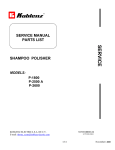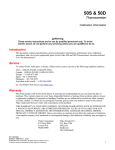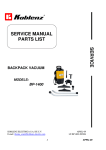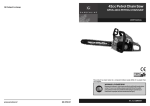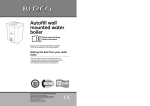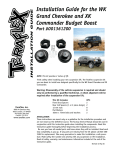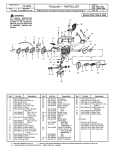Download McCulloch MS1436NAV Service manual
Transcript
Service Manual MCCULLOCH CHAIN SAW - MS1436NAV NOTE: These materials are for use by trained technicians experienced in the service and repair of outdoor power equipment of the kind described in this publication, and are not intended for use by untrained or inexperienced individuals. These materials are intended to provide supplemental information to assist the trained technician. Untrained or inexperienced individuals should seek the assistance of an experienced and trained professional. Read, understand, and follow all instructions and use common sense when working on power equipment. This includes the contents of the product’s Operators Manual, supplied with the equipment. No liability can be accepted for any inaccuracies or omission in this publication, although care has been taken to make it as complete and accurate as possible at the time of publication. However, due to the variety of outdoor power equipment and continuing product changes that occur over time, updates will be made to these instructions from time to time. Therefore, it may be necessary to obtain the latest materials before servicing or repairing a product. The company reserves the right to make changes at any time to this publication without prior notice and without incurring an obligation to make such changes to previously published versions. Instructions, photographs and illustrations used in this publication are for reference use only and may not depict actual model and component parts. © Copyright 2005 MTD Products Inc. All Rights Reserved. MTD Products LLC - Product Training and Education Department FORM NUMBER 769-01424 9/2004 TABLE OF CONTENTS Air Filter ....................................................................................................................................................................1 Fuel Filter ..................................................................................................................................................................2 Spark Arrester Screen .............................................................................................................................................2 Spark Plug ................................................................................................................................................................3 Removal of Brake Assembly .....................................................................................................................................3 Removing the Chain and Bar ....................................................................................................................................4 Removal of Clutch and Drum Assembly ...................................................................................................................4 Removal of the Chain Oiler ....................................................................................................................................... 5 Starter Servicing ........................................................................................................................................................7 Air Gap ......................................................................................................................................................................9 Flywheel Removal .....................................................................................................................................................9 Carburetor Removal ................................................................................................................................................10 Carburetor Adjustment ...........................................................................................................................................12 Chain Tension Adjustment ......................................................................................................................................13 0 McCulloch Chain Saw MS1436NAV 1.1. MCCULLOCH CHAIN SAW MS1436NAV Using a T-25 Torx driver, loosen the shroud retaining screws and lift of the top cover. See Figure 1. Screws MCCULLOCH GASOLINE CHAIN SAWS Figure 1 The MS are McCulloch brand. They are all 42cc engines even though we rate them as less in most cases. The only difference between the models is the NAV are Non Anti-Vibration and AV is Anti-Vibration. 1.2. Lift the air filter out of air-box. See Figure 2. Model: MS1436 NAV - 14” Bar and 36CC Engine This product has been tested at a computed kickback angle (CKA) and conforms to ANSI B175.1-2000, Annex C. This Service Manual is a supplement to the User Manual. Read, understand and follow all safety procedures before operating or servicing this chain saw. Refer to the Owners Manual for procedures for proper setup and operation. Additional information can be found in the 2004 MTD Update Manual: Form number # 769-00960. IMPORTANT: Prior to servicing the chain saw, remove the spark plug wire from the spark plug. Figure 2 1.3. WARNING: Never perform maintenance when the engine is hot, to avoid any chance of burning hands or fingers. 1. AIR FILTER CAUTION: Never operate saw without the air filter. Dust and dirt will be drawn into engine and damage it. Keep the air filter clean! 1 Clean air filter. Wash filter in clean, warm, soapy water. Rinse in clear, cool water. Air dry completely. 1.4. 2.5. Remove the wire screen from the air box. See Figure 3. Lift filter out of tank. See Figure 4. Fuel Filter Figure 4 Figure 3 1.5. Wash screen in clean, warm, soapy water. Rinse in clear, cool water. Air dry completely. 2.6. Pull filter off with a twisting motion. Discard filter. 2.7. Install new filter. Insert end of filter into tank opening. Make sure filter sits in bottom corner of tank. Use a long handle screwdriver to aid in filter placement if necessary. 3. SPARK ARRESTER SCREEN NOTE: It is advisable to have a supply of spare filters and screens on hand. 1.6. 2. Install air filter in reverse order of disassembly. Install engine/air filter cover. Make sure cover fits properly. Tighten the cover retaining screws securely. NOTE: A clogged spark arrester screen will dramatically reduce engine performance. 3.1. FUEL FILTER CAUTION: Never operate your saw without a fuel filter. The fuel filter should be replaced after each 20 hours of use. 2.1. Drain fuel tank completely before changing filter. 2.2. Remove the fuel tank cap. 2.3. Bend a piece of soft wire into a hook shape. 2.4. Reach into fuel tank opening and hook fuel line. Carefully pull the fuel line toward the opening until you can reach it with your fingers. NOTE: Do not pull the hose completely out of tank. Using a 10mm socket, remove the 3 bolts securing the muffler to the cylinder. Remove the muffler. See Figure 5. Bolts Figure 5 2 3.2. 4.4. Using a medium Phillips screwdriver, remove the 2 screws that hold the spark arrester cover to the muffler. See Figure 6. Using the scrench, remove the spark plug. See Figure 7. Scrench Figure 7 Figure 6 3.3. Discard the used spark arrester screen and replace it with a new one. 3.4. Reasemble the muffler components and install the muffler to the cylinder. Tighten securely. 4. SPARK PLUG Push STOP switch down. 4.2. Remove the shroud. See AIR FILTER Section. 4.3. Disconnect the wire connector from the spark plug by pulling and twisting at the same time Check electrode gap with wire feeler gauge and set gap to .025" (.635mm) if necessary. 4.6. Reinstall a new spark plug. NOTE: A resistor spark plug must be used for replacement (McCulloch part no. 9295-310502). NOTE: This spark ignition system meets all requirements of the Canadian InterferenceCausing Equipment Regulations. NOTE: NOTE: For efficient operation of the saw engine, spark plug must be kept clean and properly gapped. 4.1. 4.5. 5. REMOVAL OF BRAKE ASSEMBLY 5.1. Disconnect the spark plug wire from the engine. 5.2. Using a 5/8” socket, remove the nut attaching the cover to the unit. See Figure 8. Torx Screw Hex Nut Figure 8 3 5.3. Using a T-25 Torx wrench, remove the screw securing the cover to the unit. See Figure 8. 5.4. Remove the cover. 6. REMOVING THE CHAIN AND BAR 6.1. Remove the brake assembly cover. See REMOVAL OF BRAKE ASSEMBLY Section. 6.2. Remove the chain from the bar. See Figure 9. Hole for Tab Figure 11 Figure 9 6.3. Lift the bar from the mounting stud and guide. 6.4. During assembly make certain that the tab from the tensioning screw fits into the hole in the chain bar. See Figure 10. See Figure 11. Tensioning Screw 7. REMOVAL OF CLUTCH AND DRUM ASSEMBLY 7.1. Remove the spark plug from the unit. 7.2. Remove the brake assembly kit cover. 7.3. Remove the chain and bar. 7.4. Place a piece of starter cord into the spark plug opening. This will aid in removing of the nut securing the clutch and drum assembly to the crankshaft. See Figure 12. Starter Cord Tab Figure 12 Figure 10 4 7.5. Using a 13mm socket, remove the nut securing the clutch and drum assembly to the crankshaft. See Figure 13. 7.7. Inspect and repair as needed. NOTE: During assembly, the machined groove in the drum/sprocket assembly must engage the tabs on the nylon worm gear. See Figure 15. Tabs Machined Groove Hex Nut Figure 13 Figure 15 NOTE: This is a left hand threaded nut. Remove in a clockwise fashion. 7.6. Remove the assembly from the crankshaft. See Figure 14. Drum Assembly 8. REMOVAL OF THE CHAIN OILER 8.1. Remove the brake kit assembly. 8.2. Remove the chain and bar. 8.3. Remove the clutch and drum assembly. 8.4. Using a number 2 phillips screwdriver. Remove the two screws securing the anti-dust cap to the chain oiler. See Figure 16. Clutch Assembly Anti-Dust Cap Screws Hex Nut Figure 14 Figure 16 5 8.5. Using needle nose pliers, remove the worm gear. See Figure 17. 8.7. Remove the shaft from the oil pipe. Inspect the shaft for damage. See Figure 19. Worm Gears Figure 17 8.6. Figure 19 Using the tip of a small screwdriver, lift the rear portion of the pump shaft from the housing. See Figure 18. 8.8. Using a small screwdriver, remove the ends of the two hoses from the housing. Inspect for damage. See Figure 20. Hose Connector Pump Shaft Assembly Figure 18 Figure 20 6 8.9. Remove the brass pump housing from the oil pipe. See Figure 21. 9. STARTER SERVICING 9.1. Using a T-25 Torx wrench, remove the four screws attaching the starter housing assembly to the housing assembly. See Figure 23. Pump Housing Torx Screws Figure 21 NOTE: The small hole in the brass pump housing must be facing up into the upper oil hose during assembly. The flats on the pump housing align with the molded tabs on the housing. Figure 23 NOTE: Replace the felt washer any time you service the chain oiler. See Figure 22. 9.2. Remove the housing from the unit. 9.3. Use a screwdriver to lift the starter cord from around the pulley and unwind the starter cord. This takes tension off the starter pulley. See Figure 24. Starter Cord Felt Washer Figure 22 Figure 24 8.10. Torque the nut securing the clutch drum assembly to the crankshaft to during assembly. 7 9.4. 9.6. Using a T-25 Torx driver, remove the screw attaching the pawl retainer to the pulley housing. See Figure 25. If the starter return spring is broken, lift of the spring retaining cover and replace the spring. See Figure 27. Torx Screw Notch Spring Retainer Cover Figure 25 Figure 27 9.7. NOTE: There is a spring under the retainer. 9.5. Replace the pawls if they are worn. NOTE: During assembly, note the proper orientation of the pawl retainer. The pawl retainer slots will face the same direction as the pawls. See Figure 26. If the starter cord is broken, attach one end of the starter rope to the pull handle. Pass the lose end of the cord through the starter housing assembly and through the pulley. Knot the end of the cord and make sure it is secure in the pulley. See Figure 28. Hold spool in place and wind cord clockwise. Place tension of spool during last two winds. Figure 28 Figure 26 9.8. 8 Wind the starter cord around the pulley. Wind the starter pulley clockwise to put tension on the spring during the last loop of the starter cord. 10. AIR GAP 11.5. Using a 13mm socket, loosen but do not remove the nut securing the flywheel to the crankshaft. See Figure 30. Using a feeler guage, measure the air gap between the flywheel and the coil. The measurement should be between .08”-.010”. Loosen the mounting screws to adjust the air gap. See Figure 29. Hex Nut Figure 30 .08”-.010” Air Gap 11.6. Unthread the nut until it is flush will the end of the drive shaft. Figure 29 11. FLYWHEEL REMOVAL IMPORTANT: If any of the air fins on the flywheel break off for any reason, a serious imbalance and resulting vibration and damage to the engine will occur. 11.1. Remove the spark plug from the engine. 11.2. Place a length of starter cord into the spark plug opening. This will ease removal of the flywheel. 11.3. Using a T-25 Torx wrench, remove the four screws attaching the starter housing assembly to the housing assembly. 11.4. Remove the housing from the unit. 9 12.4. Using a small screwdriver, lift out the metal screen. 11.7. Place a large screwdriver under the flywheel and while applying upward pressure, tap on the nut on the drive shaft to release the flywheel from the shaft. See Figure 31. 12.5. Using a 8mm socket, remove the two nuts securing the air filter assembly to the carburetor. See Figure 33. Hex Nuts Hex nut flush with end of crankshaft Figure 31 Figure 33 NOTE: There is an alignment key in the drive shaft. During assembly make sure the key does not slip out of the keyway. See Figure 32. 12.6. Using a screwdriver, pry the wire harness from the clip on the air filter assembly. See Figure 34. Machined slot Key Wire Harness Figure 32 Figure 34 11.8. Torque the nut to during assembly. 12. 12.7. Release the air filter assembly from the two mounting bolts, slide it to the left and remove it from the carburetor. CARBURETOR REMOVAL 12.8. Inspect the brass colored fuel tank breather for any blockage. 12.1. Disconnect the spark plug wire. 12.2. Using a T-25 Torx driver, remove the three screws securing the top cover. Remove the cover. NOTE: Blockage of this breather will allow the chainsaw to operate briefly but then stop due to lack of fuel. 12.3. Lift out the foam air filter. 10 12.9. Using a small flat bladed screwdriver, pry the fuel line from the carburetor inlet. See Figure 35. 12.11. Pry the choke handle from the carburetor. See Figure 37. Fuel Line Choke Lever Figure 35 Figure 37 NOTE: In order to remove the throttle cable from the carburetor it will be necessary to remove the left side of the handle assembly and create slack in the cable. 12.10. Lift up on the choke lever to remove the rubber grommet from the housing. See Figure 36. 12.12. Using a T-25 Torx driver, remove the four screws securing the handle halves. 12.13. Remove the left handle half. 12.14. Raise up on the trigger assembly enough to allow removal of the throttle cable from the trigger. See Figure 38. Throttle Cable Rubber Grommet Choke Lever Figure 36 Figure 38 12.15. Push the throttle cable and housing towards the saw body. 11 12.18. Remove the primer tube from the lower left side of the carburetor. See Figure 41. 12.16. Pull rearward on the carburetor until it clears the two mounting screws. See Figure 39. Mounting Screws Primer Tube Figure 39 Figure 41 NOTE: You can replace the carburetor as a complete assembly if it is obviously gummed up beyond repair or you can purchase a rebuild kit and rebuild the carburetor in about 15 minutes. 12.17. Rotate the carburetor forward and to the left in order to remove the throttle cable from the carburetor. See Figure 40. NOTE HOLES 12.19. Install the carburetor in the reverse order of disassembly. 13. CARBURETOR ADJUSTMENT The carburetor was pre-set at the factory for optimum performance and to meet all federal and state emission guidelines. Unless you are a trained service professional, take your unit to the nearest Authorized Service Center listed in the Yellow Pages for any adjustment. The carburetor does have Low and High adjustment screws for qualified. technicians. See Figure 42. Throttle Cable Figure 40 NOTE: Note which hole the throttle cable is attached to on the carburetor. Low Setting High Setting Figure 42 12 14. CHAIN TENSION ADJUSTMENT 14.1. Chain tension adjustments can be made using a standard screwdriver. See Figure 43. Tensioner Screw Figure 43 NOTE: Follow proper chain tensioning procedures outlined in the User Manual. 13

















